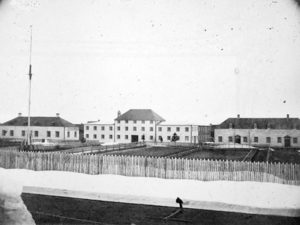York Factory
York Factory was the operational headquarters of the powerful Hudson’s Bay Company (HBC). Situated in northern Manitoba, where the Hayes River meets the Hudson’s Bay, the Hudson’s Bay Company established York Factory in 1684 as a fur trading post. The region was home to both European traders and a group of Swampy Cree, today known as the York Factory First Nation. In its early years, the region’s Swampy Cree were vital to the site’s survival, providing York Factory with furs and other goods while also acting as hunters, guides, packers and couriers. The York Factory area was also the home of Jeremiah Johnston’s mother, herself half Cree, before she moved south to St. Peter’s.
The Great House
It was for good reasons that the local Swampy Cree called York Factory Kihciwaskahihan, “the great house.” At its peak in the mid-nineteenth-century, York Factory was the administrative centre of Rupert’s Land, the HBC’s vast territorial holding that comprised the entire Hudson Bay drainage basin, or a third of what is now modern Canada. The Hudson Bay Company constructed over fifty buildings at the site and employed a vast workforce of Europeans and Swampy Cree peoples. Many Swampy Cree worked at and around York Factory as traders, provisioners, wage labourers and consumers. Yet as the HBC began to restrict its employment of Indigenous peoples to manual labour tasks, the Swampy Cree at York Factory were demoted to lowest level of the labour hierarchy. Nonetheless, the Swampy Cree continued to establish seasonal communities around York Factory and developed a more permanent settlement at the post itself.
Treaty 5
In 1910 the Canadian government extended Treaty 5 to include the York Factory band. Initially, the government thought the land in northern Manitoba to be of negligible agricultural value and therefore not worth including under the already existing Treaty 5, and consequently excluded many northern Manitoban Indigenous peoples from its signing. Yet the government took a new interest in northern Manitoba and its Indigenous inhabitants following the discovery of oil in the region, as well as the creation of the new province of Saskatchewan. Yet like Treaty 3 and its relationship to the Rainy River Ojibwe, the government failed to provide the support Treaty 5 promised to its Indigenous signatories. Furthermore, the reserves outlined by Treaty 5 were on average smaller than those in preceding treaties, and provided smaller monetary payment.
Decline and Closure
With the advent of the railways, York Factory was no longer a vital port and the settlement and its surrounding Indigenous communities declined rapidly in size. The site was finally closed in 1957, leading to the relocation of the York Factory First Nation to the area of York Landing, roughly halfway between the Hudson’s Bay and Lake Winnipeg. Cree Elders present during the relocation still remember today how they were forced to leave their homes and go to less desirable land. Some still occasionally visit the old site and home of their childhood and heritage. The old York Factory site is now operated by Parks Canada.
Sources
Coutts, Robert, and Flora Beardy. Voices from Hudson Bay: Cree stories from York Factory. Montreal: McGill-Queen’s University Press, 1996.
Coutts, Robert. “York Factory as a Native Community: Public History Research Commemoration and the Challenge to Interpretation.” Prairie Forum 17, no 2 (1992): 275-94.
